by Reneé Mizar
Communications
Coordinator, Museum & Arts Center in the Sequim-Dungeness Valley
Within a few months of moving to Sequim in 2002, DJ Bassett found himself in the passenger seat of Johnny Knapman’s pickup truck, crisscrossing Sequim-Dungeness Valley back roads and soaking up colorful tales that only an area old-timer such as Knapman could recount.
In that first trip, as barter payment for historical photo preservation work, Bassett began learning of local lore and the founding families whose imprint on the land is as apparent as the rural roads, creeks and city streets bearing their names. Through friendship with Knapman and other longtime area residents such as Knapman’s brother Bill, Irv Boyd, Tom Taylor, Doug McInnes and Bob Clark, he developed a working knowledge of area history that serves him well as executive director of the Museum & Arts Center in the Sequim-Dungeness Valley.
“I listen to their stories, hear lies and tell some, and generally share a camaraderie only found in small towns where people have grown up with each other and experienced their good times and bad together over the years,” said Bassett, who grew up in rural Saunemin, Ill., population 350. “I found these guys to be the same kind of people that would have been in my hometown in the 1950s and 1960s. Sequim became kind of a mini-time machine for me. I felt like I’d returned home.”
Hired as MAC executive director in January 2011, Bassett said in his job no two days are alike. On any given workday, he may find himself in back-to-back meetings, planning projects and programs, assisting in event setup, providing training on photographic scanning, attending an exhibit’s opening reception or traveling to the far reaches of the valley to meet one-on-one with an area old-timer.
Those meetings in particular, Bassett said, speak directly to the MAC’s mission of preserving area heritage and help maintain the type of personal connections that are vital to the MAC’s future.
Mutual support
Founded in 1976 as the Sequim-Dungeness Museum by a handful of area residents interested in preserving local history, the MAC has grown into a multifaceted organization with two full-time and six part-time staffers and more than 100 volunteers. It encompasses four Sequim facilities — the MAC Exhibit Center, the historical Dungeness Schoolhouse, the DeWitt Administration Center, and the Second Chance Consignment Shop.
The MAC marks its 36th anniversary at 5 p.m. Saturday, April 28, with the MAC Nite Dinner Auction, its primary annual fundraiser, at the Sunland Golf & Country Club. The event includes a catered dinner, live music by Chez Jazz and silent and live auctions.
“We are a customer service organization, and we, in turn, need community support to continue,” Bassett said. “Like all community-based organizations, we don’t operate in a bubble.”
Cultivating community
Bassett, his staff and volunteers have worked over the past 18 months to increase the MAC’s membership numbers and strengthen its infrastructure. They address deferred maintenance issues, write grants applications and seek other sources of funding to create a sound, sustainable foundation for the MAC.
“With all of the challenges have come opportunities,” Bassett said. “We have very dedicated volunteers, staff, members, and other friends of the MAC who answered the call almost immediately and pitched in to move toward the vision that I have for this organization.”
In addition to elevating the MAC’s public presence, Bassett has led cooperative outreach between the MAC and other organizations across the North Olympic Peninsula, including the Jamestown S’Klallam Tribe, the City of Sequim, and the North Olympic Library System. Sustaining such connections, said Bassett, helps ensure the MAC’s future not only as a regional history- and arts-based organization, but also as a community cultural center.
Whether through one-on-one personal interaction or group collaboration, Bassett said, in the end his job really comes down to people, both those with whom he works and those the MAC serves.
“Wherever I am in the community, people, some that I know and some that I don’t know, come up to me and express satisfaction at the direction the MAC is taking, whether it be in the arts, history, or other aspects of the organization,” Bassett said. “I consider that the most rewarding aspect of this job and the work that we do here.”



